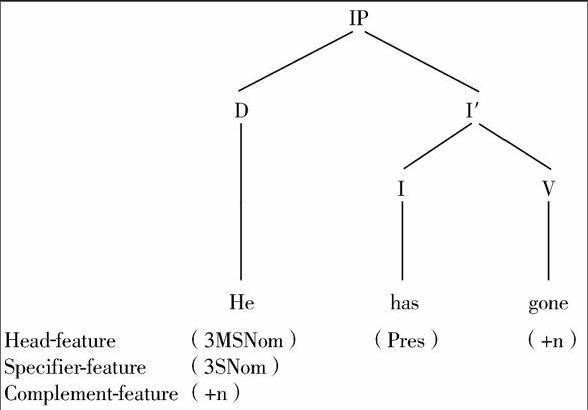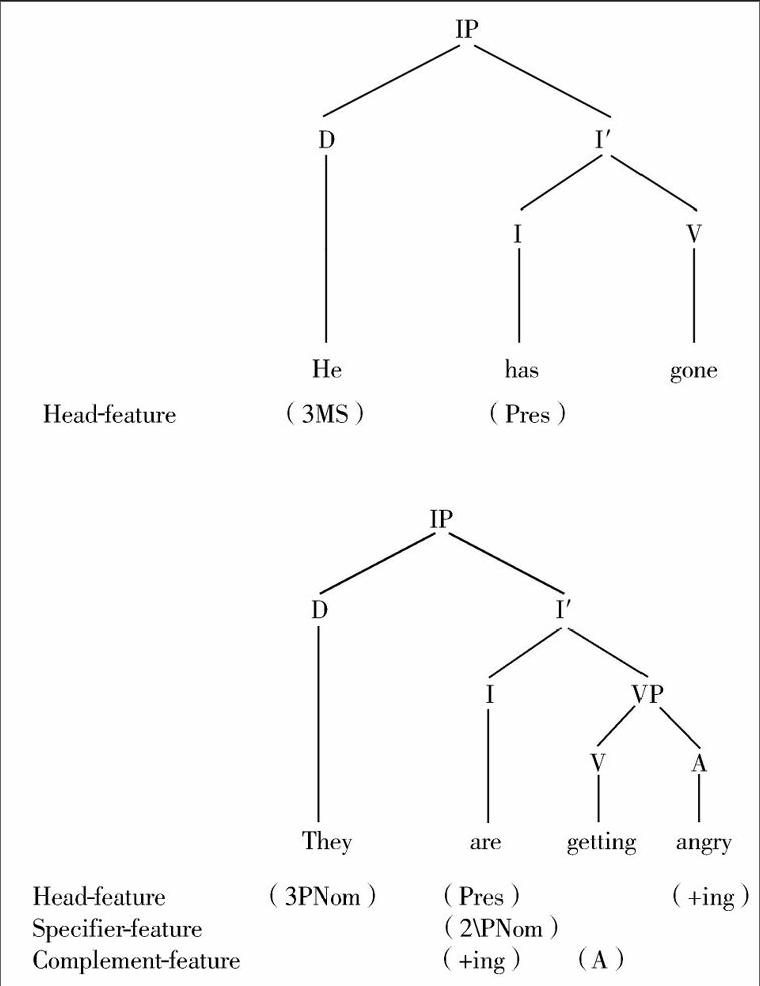A Study on Feature Checking Theory
2014-05-20王艳丽


作者简介:王艳丽(1982—),女,江苏丹阳人,硕士研究生,无锡高等师范学校小学教育系讲师,研究方向:语言学、语义学。
1Introduction
The morphological properties of words can be characterized in terms of sets of grammatical features: headfeatures (which determine their intrinsic grammatical properties), specifier-features (which determine the kinds of specifier which they allow) and complement-features (which determine the kinds of complement they can take), and features must be checked in an appropriate manner. This paper mainly focuses on a brief introduction to the concept of checking.
2Interpretable features and uninterpretable features
Before we start future-checking, we just note some key concepts about interpretable features and uninterpretable features. The syntactic structures generated by merging pairs of categories together are used as the basis for computing two types of structural representation for a sentence: a representation of its phonetic form (=a PF-representation),and a representation of its phonetic form(=an LF-representation).In simple words, the PF-representation of a sentence tells us how it is pronounced, and its LF-representation of a sentence tells us how it is pronounced, and its LF-representation describes linguistic aspects of its meaning.( Andrew Redford,2000:70) Furthermore, we noted that some grammatical features ( e.g. the personnumbergender-features of pronouns )have semantic content and so are interpretable (at LF),whereas others ( e.g. the case futures of pronouns and the inflectional features of nonfinite verbs)are uninterpretable (at LF) by virtue of having no semantic content, and that LF-representations may contain only (semantically)interpretable features. If a derivation gives rise to an LF-representation which contains only (semantically) interpretable features, the relevant derivation is said to converge (at LF); if it gives rise to an LF-representation which containing one or more (semantically) uninterpretable features, the derivation is said to crash (at LF),and the corresponding sentence is ill formed. Thus, the grammatical features are checked in the course of a derivation, and that uninterpretable features are erased once checked.
3Future-checking
Chomsky (1995) develops a theory of future-checking designed to ensure that how the grammatical feature carried by the different words in a sentence are compatible with those of other words in the same sentence.
To make the discussion more concrete, we just look at how grammatical features are checked in a simple sentence such as:endprint
(1) He has gone.
(Here we are concerned only with grammatical features: hence we ignore phonetic and semantic features.) The head feature of he indicate that it is third person masculine singular nominative determiner; those of has that it carries present tense; and those of gone that it is an n-participle (i.e. a perfectivepast participle). The specifier-features of has told us that it requires a third person singular nominative subject; and its complement-features indicate that it requires a complement headed by a verb in the n-participle form. Since neither he nor gone has a specifier or complement here, we just assume that in the relevant uses their head and complement-feature specify that they can be used without any specifier or complement. Accordingly,“ (1) He has gone.” will have the structure below:
(3=third person, M=masculine, S=singular, Nom=nominative case, Pres=present tense, +n=n-participle; the blank entries for the specifier- and complement-features of he and gone mean that (in this use) they dont have a specifier or com plement).The features within square brackets provide an informal indication of the fact that mentioned above.
Before we consider how the process of feature-checking works in (1), we just make the assumption that the specifier-feature of a head must be checked against the head-feature of (the head word of) its specifier; and likewise, the complement-feature of a head must be checked against the head-features of (the head word of) its complement. If there is a match between checker and checked in respect of any given feature, the relevant specifier- or complement-feature is erased (because specifier-and complement-feature are uninterpretable),and the corresponding head-feature is erased if it is uninterpretable (but is not erased if interpretable). If there is a mismatch between checker and checked in the respect of some feature, the relevant feature can not be erased from either. (Andrew Redford, 2000:72)
In the example “He has gone”, the specifier-features of has are checked against the head-features of he. The〔3〕(third person) and 〔S〕(singular) specifier-features of has exactly match the〔3S〕head feature of he: since the relevant features play a role in the interpretation of he but not in that of has, the 〔3S〕specifier-features of has are erased, but the〔3S〕head feature of he are not. The〔Nom〕(nominative case) specifier-feature of has exactly matches the〔Nom〕 head-feature of he, and since case-features play no role in semantic interpretation, both〔Nom〕features are erased. Furthermore, when the complement-features of has are checked against the head-features of gone, they match exactly. And the inflectional properties of nonfinite verbs (like the case properties of pronouns) play no role in semantic interpretation, both 〔+n〕features will be erased. Thus, checking in “(1) He has gone.” will mean that the only grammatical features which survive in the corresponding LF-respresentation are those in below:endprint
All specifier-and complement-features have been erased (because they play no role in semanticinterpretation). Likewise, uninterpretable head-features (e.g. the nominative case-feature of he and the 〔+n〕inflectional feature of gone) have also been erased, because they are uninterpretable. The only grammatical features which survive at LF are interpretable head-features.
Having looked at how specifier- and complement-feature are checked in simplestructure, lets consider how checking works in more complex structure such as below:
(2)They are getting angry.
Consider how the relevant feature can be checked. The〔A〕complement-feature of getting require (requiring it to have an adjectival complement) can be checked (and erased ) straightforwardly; Since the complement of getting is angry. Since getting is an –ing head, and can be checked the〔+ing〕complement feature of are(requiring are to have an ing-complement), so that both 〔+ing〕features can be erased. The〔Nom〕specifier feature of are exactly matches the〔Nom〕head-feature of they, and since case-features play no role in semantic interpretation, both 〔Nom〕features are erased.As they will be the third person plural nominative expression, it can check or erase the〔2\\PNom〕specifier-feature of are. Thus,only features which survive at LF are the interpretable〔3P〕third person plural head-features carried by they, and the 〔Pres〕present-tense head-feature carried by are.
4Conclusion
To sum up,the grammatical features carried by words can be checked according to the feature-checking theory.However, it should be noted that work on checking theory is as yet in its in fancy, so that many of the ideas and descriptive details in this theory are still speculative.
参考文献:
Radford,A.. Syntactic theory
and the structure of English .Cambridge: Cambridge University Press, 1997.
Radford,A.. Syntax: A minimalist Introduction .北京:外语教学与研究出版社,2000:70—72.
温宾利.当代句法学导论 .北京:外语教学与研究出版社,2002.endprint
